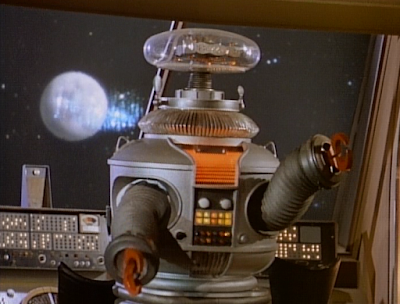In
“The Ghost Planet,” the Jupiter 2 passes through a zone of radiation on the way
to an unexplored planet. Dr. Smith (Jonathan
Harris) erroneously believes the planet is Earth, despite the fact that the
Robinsons are now in another galaxy all together.
Upon
landing on the planet, the red carpet is literally rolled out for the
Robinsons. They are welcomed as guests by unseen but apparently friendly hosts.
Smith
goes out first, expecting to meet the U.S. President. Instead, he is captured by the robot denizens
of the planet.
These
robots – “Supreme Prototypes of
Cybernetic Beings” – exist in both humanoid and non-bipedal
form, and. want to enslave the humans. They require them to work on a robot
assembly line.
When
Smith and Will (Bill Mumy) are captured and put to work, the Robot pretends to
be on the side of the planet’s machine inhabitants so he can help them escape.
“The
Ghost Planet” is marginally better than last week’s installment, “Wild
Adventure,” though that’s not actually saying a whole lot.
This week, machine-people (who resemble the
humanoids of the Cygnus, in 1979’s The Black Hole), one alien robot leader and an organic, pulsating brain attempt to enslave the Robinsons.
Once
more, the majority of the episode’s action goes to Smith, Will and the Robot. Smith
is captured (again), Will goes out to rescue him (again), and the Robot is
given perhaps the most interesting part of all.
He gets to play at being treacherous, attempting to gain the trust of
the alien machines. It would have been
awesome if he remembered to call the robot leader a ‘robotoid’ since we had
that term defined for us by him in “War of the Robots” in the first season. But
he doesn’t.
Still, the Robot’s role is
the most intriguing aspect of the story.
Although we love the robot, viewers may experience moments in which they wonder if he
has become loyal to those of his “own kind,” over those in his family, the
Robinsons. Yes, he’s proved himself many
times before, and yet still the tension around his behavior in “The Ghost
Planet” is real. Perhaps, this is some form of comment on our inherent distrust of technology.
“The
Ghost Planet” has little to recommend it other than some nice colors, and a
high level of action. In this case, it is useful to compare Lost
in Space to Star
Trek. Think of an episode of Trek,
like “The Man Trap,” which seems to possess a basic or familiar plot. It involves a Salt Vampire, a monster,
killing crewmen on the starship.
Yet
that episode holds up well today, because the monster is contextualized as
being the last of its kind. Dialogue
explicitly compares “the monster” to Earth’s buffalo. By focusing on this idea,
the story becomes something more than a monster-on-the-loose tale. We actually come to sympathize with the
monster.
Here,
Lost
in Space sets an episode on a robot planet, but has virtually nothing of
value or interest to tell us about that society, or what it means in a human
sense. The robots attack and capture
beloved characters, but we still know nothing about them, or their
culture.
The machines need humans to
work on a robot production assembly line, but the episode makes no observation
about that fact. In short, the story
might have been about the way that automation dehumanizes us, or how our
technology could replace us in the right set of circumstances. But “The Ghost
Planet” features none of those touches at all: it’s a straight-forward
run-around, with no depth, and no real humanity. The robots are just villains to escape from,
not a carefully-examined alien civilization.
Importantly, Lost
in Space is not always so insipid. I feel like I must point that out. “The Magic Mirror,” for example, is about growing up, and uses a
stagnant alternate dimension to describe the Peter Pan principle. Staying young
is great, but not if you don’t change.
Not if you don’t grow. “The Ghost
Planet” desperately needs some kind of angle like that so that it is not just
senseless phantasmagoria. The episode
never stops moving, but it never really gets anywhere, either.
Next
week: “Forbidden World.”















John,
ReplyDeleteThis episode is probably going to look terrific on the Blu-Ray, which is released in one month. The extended action sequence at the end, in which the Jupiter 2 is dodging missiles, is really nice.
The episodes from here on out don't offer much in the way of depth. They're silly and fun (when they're good), but the lament of almost every LIS fan is that they turned away from the tone of those great first season episodes.
Irwin Allen had plans to add a talking llama to the cast in the fourth season. A TALKING LLAMA. Bearing that in mind, things could have been much, much worse.
Steve
I do have to say, that the one really bright spot for me as a kid was the Robots snark to Dr. Smith when he's driving them to "work, work" and Smith asks for some response, and the Robot replies, "Have no Fear, Smith is here, Ha Ha Ha! Work!"
ReplyDeleteStill, the downward trend will continue, unfortunately, and makes me wonder what would happen if someone else had taken over from Allen.
John I am glad you noticed the "zygote" in this episode of the machine-people who resemble the humanoids of the Cygnus, in 1979’s The Black Hole.
ReplyDeleteGood review of a simple episode.
SGB
Classic LOST IN SPACE.
ReplyDelete